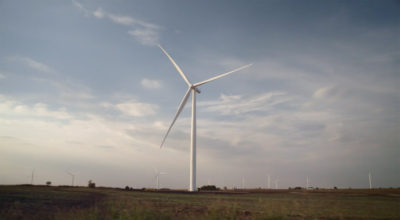The Morgan County Zoning Board of Appeals voted to recommend the Lincoln Land Wind Project’s WECS application last night. Prior to the meeting WLDS News had received a screenshot of the meeting’s agenda with what appeared to be votes cast in favor of the project ahead of the meeting.
The Edgar County Watchdog group posted a screenshot of the meeting showing that the motion to recommend had already passed 4-0 with one abstention. Morgan County Zoning’s legal counsel Mike Jarusic said during the public comment question and answer period that the italicized votes at the bottom of the agenda was based off a consensus of the board members at the previous public hearing on August 11th and said that no violation of the Open Meetings Act had occurred.
Morgan County Planner Dusty Douglas also reiterated that point when questioned after the meeting about the alleged impropriety: “We had the framework out [for the public], in fact, we had for the last meeting, which was kind of for the Board of Appeals to follow. As Counselor [Jarusic] mentioned, everything was italicized that if they would have acted, the [agenda] was set up for them to make a motion. In the last meeting, a couple of motions were floated out there and never went anywhere. Nothing was acted upon and they chose to meet again today. With that, we had a framework for tonight. We kind of went through the entire [application] with the conditions laid out, and at the end of those conditions, the italicized print [appeared] that basically kind of framed it up for the board that if you want to make this motion, this is the way it’s done. After the notations, we’re going to get a letter from and re-racked Dan Little, the chairman, based upon what happened tonight and take that to the county board.”
Douglas also said that no meetings or votes took place outside of the public prior to the meeting. Board member Jimmy Duncan said prior to the vote that he would be abstaining because a public service organization which he works for, the AMVETS, had previously received money from Apex in the form of a grant and did not want the appearance of impropriety on his part in voting. The vote ended up passing 4-0 with the abstention.
Douglas says that criticism surrounding the application and the findings from Patrick Engineering is unfounded and that the application should not appear incomplete: “It’s really not [incomplete] when you compare their projects, projects you see in neighboring counties. There are so many conditions that have to be added to be nailed down. It’s kind of a two-part permitting process. We are going to grant the site permit, but there is still additional work that has to be done before a construction permit is issued. Also, anyone can take a look at some of the things that come through the city and local villages – a simple construction project may have 8 or 9 conditions on it. For a project of this magnitude, I don’t think it’s really an inordinate number.”
One of the conditions that was brought up during the meeting by Morgan County resident Stephanie Bergschneider was the aircraft warning system lighting and if the FAA had approved Apex’s permit for the 107 turbines in the county. She wanted to know if the lack of an approval would halt the project. Senior Vice President of Development Karlis Povisils says that the ADLS lighting plan has been filed with the FAA as a next step in the project, as one of the conditions to the citing permit: “Our understanding is that the FAA approval process is about 60 days. They will be looking at what are the different angles, what’s the radar coverage if it’s sufficient or not, and they will either say: ‘Good as proposed’ or they might recommend some kind of adjustment. They’ve stated that it’s about a 45 to 60 day approval process, and we expect to have that.”
Povisils says that it shouldn’t delay the project if the FAA decides to not approve the lighting plan. He says that the FAA has generally worked with them in the past to fix any issues quickly. Povisils says the reason he doesn’t foresee any problems is because of the generally flat topography of the footprint of wind farm: “If we were right next to a city with tall buildings or if it was surrounded by mountains where the fear would be that a plane is approaching and not have enough time to react – then I think it would be a longer permitting process or the FAA would recommend repositioning of radar or adding additional radar units along the perimeter of the project. Here, it’s very flat. There are no rolling hills. There are no large cities with tall buildings nearby. This should be a rather straightforward process.”
Povisils told the Zoning Board last night that construction isn’t likely to begin until 2022, even though Apex would like to get moving next year. Povisils indicated briefly that GE would likely be the manufacturer of the turbines.
Zoning Board member Dale Bainter told Apex representatives that he would also like to continue ongoing conversations about infectious disease and possibly COVID-19 mitigation if it is still a factor in the near term for transient workers for the project. Senior Development Manager Holly McCoy says the project is supposed to bring 300 or more temporary construction jobs to the region over a 6 to 12 month time period, with 9 to 11 full-time, permanent operations and maintenance jobs. Rural Jacksonville resident Marla Twyford expressed her concern for bringing that number of people from out of town and out of state during a pandemic for a construction project. Bainter, who is the Director of the Morgan County Health Department, did not discuss what further conversations needed to be had based on current and future COVID-19 or other major health concerns and restrictions during the meeting.
Bergschneider also mentioned during public comment that the sound modeling within Apex’s application was deficient and didn’t accurely reflect sound from the turbines heard in the wind farm’s footprint. Bergschneider asked for a sound study be completed within 6 months of the completion of the project for compliance purposes. McCoy says that a sound study on the turbines will be completed within 1 year after the project is up and running in accordance with the Morgan County WECS ordinance: “Sound is a matter of perception. I have them in the county that I live in. We have brought several people out, including some folks that aren’t in favor of the project, to our Hoopeston site to hear what [the turbines] sound like. For me to describe what I think they sound like [doesn’t work], it’s better if they can just hear it for themselves. We tried to provide that opportunity. We are subject to the noise standards for the State of Illinois and we have to comply with those.”
Douglas says that conditions for decommissioning funding and road use agreements are still in discussion but the conditions will be met prior to construction beginning. Following approval by the Board of Appeals, the siting permit will go to the Morgan County Commissioners for approval. The final step in the process is an approval of a construction permit before the project’s visible construction begins in earnest.




